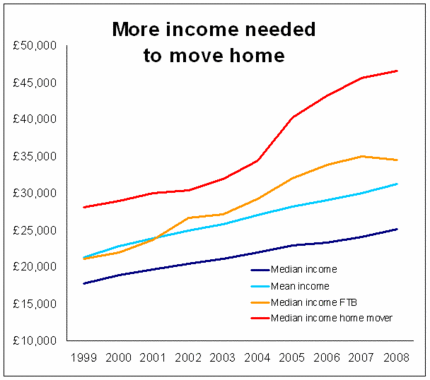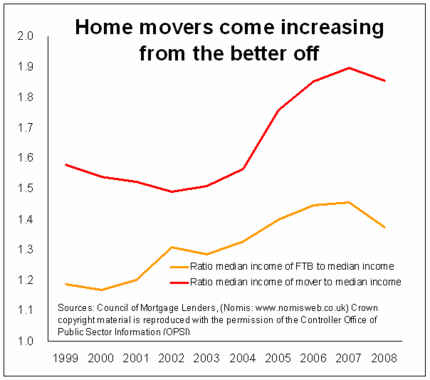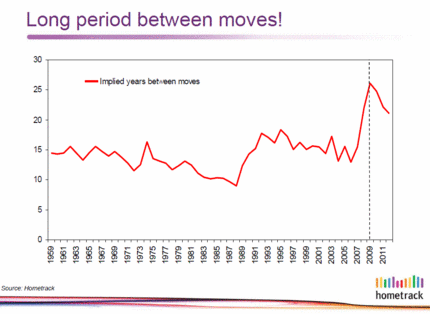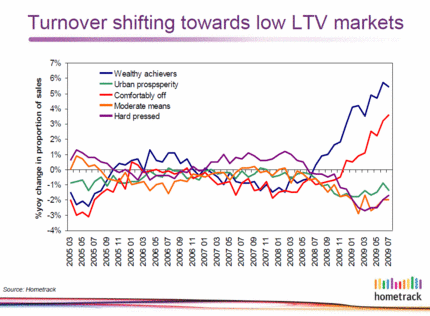The stagnant housing market: More a problem of first-time movers than first-time buyers
First-time buyers are increasingly becoming trapped in their first-time homes and unable to move on to homes that better suit their needs.
That at least is the implication of some figures that caught my eye recently when I was looking though some data produced by the Council of Mortgage Lenders.
Consider this: the median income of a household taking out a mortgage to move is £47,328, or it was in August this year. In 2000 that figure would have been £29,000. This represents a 60% increase in the median earnings of home movers against a 33% increase in median earnings across the UK as a whole.

 Graph 1 shows the rise in the median household income of first-time buyers taking out mortgages and of house movers along with the median and mean incomes across the UK as a whole.
Graph 1 shows the rise in the median household income of first-time buyers taking out mortgages and of house movers along with the median and mean incomes across the UK as a whole.
Graph 2 shows the ratio of the median household income of both first-time buyers and house movers to the UK median income.
It would seem that the threshold of earnings to be able to move is rising. This in turn strongly suggests that the proportion of first-time buyers able to trade up is diminishing – and probably diminishing fast.
And these figures do not take account of the fact that cash buyers have become an increasingly large part of the home-mover market.
If the figures mean what I strongly suspect they do then current policy appears to be giving large numbers of desperate first-time homebuyers a leg up into a housing trap.
What is more, as the graphs suggest, this is a problem that seems to predate the credit crunch, so is not simply about access to finance.
The implications for the housing market are huge and the social implications are equally, if not more, worrying. As more people struggle to get onto the housing ladder and move into a home that will “do for the time being” an ever increasing number are becoming trapped in what rapidly becomes inappropriate if, say, they wish to have, or indeed have children.
If one were to listen to politicians, one would be of the view that the biggest problem inhibiting the functioning of the housing market is that first-time buyers are being excluded from the market. And certainly policy is shaped to encourage increasing numbers of would-be buyers into the market.
And it is the denial of access to the market that grabs the attention of the media, which tend to place the blame more often than not on the lack of mortgage finance and the tough terms than lenders now have to satisfy.
But the CML figures suggest that the more the problems for would-be first-time buyers are solved the more the problem of would-be first-time movers will grow.
The reason for why this problem is occurring is simple – we have a house buying and mortgage finance culture geared up for a relatively high inflationary (high interest rate) environment being applied in low inflationary (low interest rate) times.
In effect, the front-end-loaded financing of homes that was part and parcel of living in a high inflation high interest rate world meant that “real” equity was quickly established by first-time buyers. They saw the real value of their loans quickly eroded as their earnings rose and house prices rose in line with them.
In the 1980s and to a lesser extent in the 1990s, first-time buyers who mortgaged themselves up to the hilt in the main were within a year or two far more easily able to afford their mortgages. And by and large within three to five years (or less even) were able to consider trading up. Not so now.
So moves are made far less frequently. A graph presented by Richard Donnell of Hometrack at this year’s Housing Market Intelligence caught my attention (see Graph 3).

At current rates of property transactions households are moving once every 25 years. What is more as Graph 4 (also from Donnell’s Housing Market Intelligence presentation) shows the effects of the credit crunch have meant that, even more than before the financial crisis, acquiring a mortgage to move home is increasingly a preserve of the better off.

I don’t present this as a definitive thesis on the subject, more as thoughts and concerns. And having spoken to various industry experts, there does seem to be a broadening view that there are structural problems in the marketplace created by “trapped” homeowners.
But certainly if the real problem lies more with first-time movers rather than the first-time buyers then there is a need for a radical rethink of housing policy.
Unfortunately the solutions, whatever they might be, are likely to be extremely complex at best and/or probably unpalatable, socially and politically, at worst.
One thought on “The stagnant housing market: More a problem of first-time movers than first-time buyers”
Brian
This is really thought provoking stuff.
Having moved 4 times in 5 years in the South East housing market in the 1980’s I can see where you are coming from. We traded up from a tiny bedsit to a I bed flat to a 2 bed ex LA terrace to a 3 bed semi. We also weathered high interest rates but just managed to avoid negative equity and for the most part we were able to time our moves well enough to avoid being ‘stuck’ in a property. We spent 10 years in our semi before my husband’s redundancy forced our move 600 miles North.
Have you looked at differentials between property types, and by that I mean what it costs to trade up from 1 bed flat to 2 bed flat or semi to detached or to get a garden or garage etc?
Have you considered the fact that there may be a glut of (still unaffordable) starter home size properties with a corresponding shortage more family size homes with the corresponding premium placed on the price.
Comments are closed.